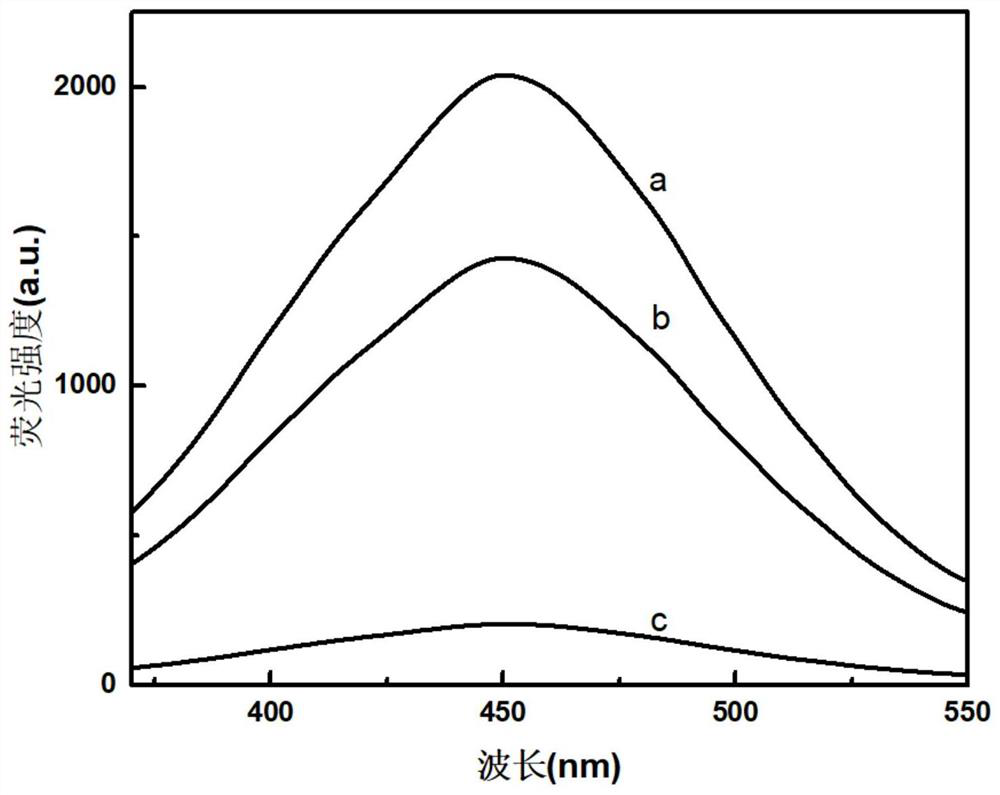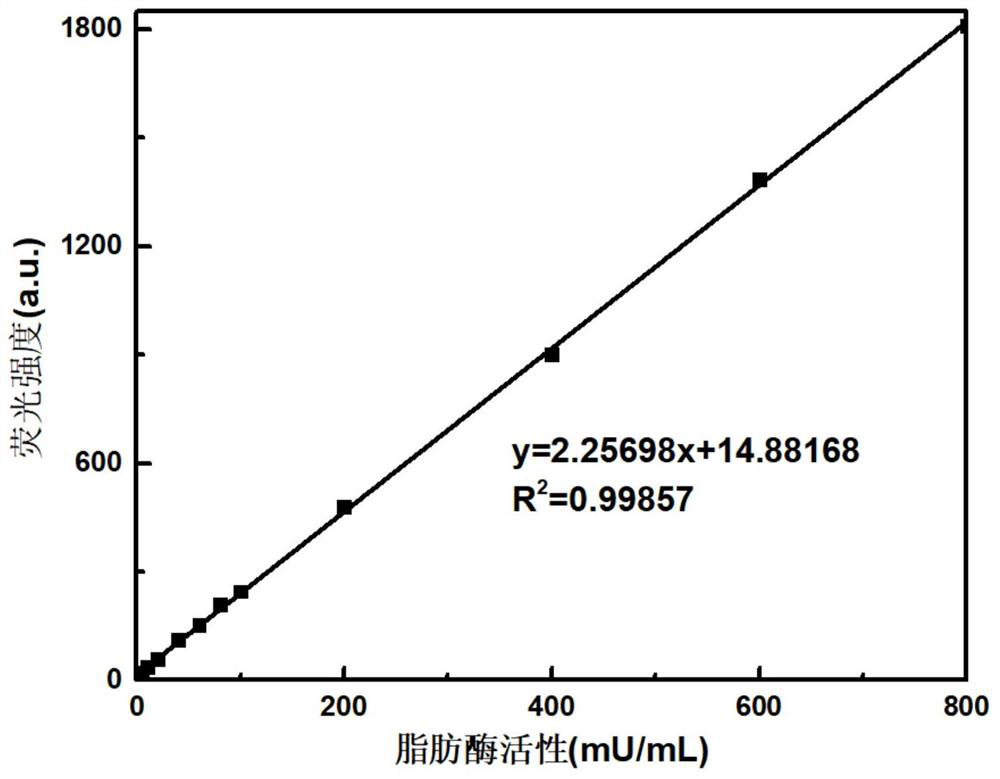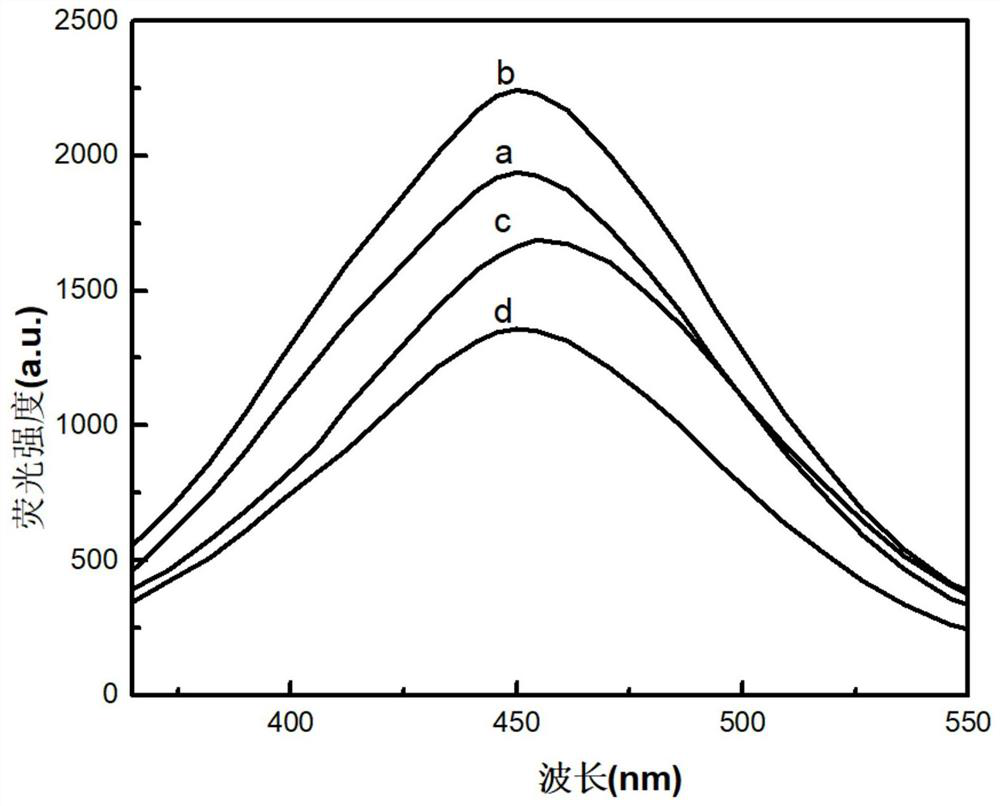A method for detecting lipase activity based on fluorescent probe
A fluorescent probe and detection method technology, applied in the field of lipase activity detection, can solve the problems of high detection limit, limited effect, low sensitivity and the like
- Summary
- Abstract
- Description
- Claims
- Application Information
AI Technical Summary
Problems solved by technology
Method used
Image
Examples
Embodiment 1
[0056] The present embodiment provides a method for testing lipase activity based on a fluorescent probe, comprising the following steps:
[0057] S1, after 1.92g citric acid, 0.72g ethylenediamine and 0.61g chloroauric acid are mixed, be dissolved in 30mL deionized water, obtain mixed solution, now the mol ratio of citric acid, ethylenediamine and chloroauric acid is 100: 12:1.5; the mixed solution was heated and stirred at 80°C for 10min, then moved into an autoclave lined with polytetrafluoroethylene, heated at 160°C for 12h, and then naturally cooled to room temperature to obtain nitrogen gold Co-doped carbon nano-dot crude product; centrifuge the nitrogen-gold co-doped carbon nano-dot crude product at a speed of 10000r / min for 10min to remove larger particles, and then use a 0.22μm microporous membrane to centrifuge The supernatant was filtered, and the obtained filtrate was purified nitrogen-gold co-doped carbon nanodots.
[0058] S2. The 2mL activity was respectively 0...
Embodiment 2~3 and comparative example 1~2
[0068] Embodiment 2 ~ 3 and comparative example 1 ~ 2 provide a kind of preparation method of carbon nano-dot respectively, compare with the step S1 of embodiment 1, difference is to change nitrogen source ethylenediamine and gold source chloroauric acid The dosage. The molar ratios of citric acid, ethylenediamine and chloroauric acid corresponding to Examples 2 to 3 and Comparative Examples 1 to 2 are shown in Table 1.
[0069] Table 1 The mol ratio of citric acid, ethylenediamine and chloroauric acid corresponding to Examples 2~3 and Comparative Examples 1~2
[0070] Example / Comparative example Molar ratio of citric acid, ethylenediamine and chloroauric acid Example 2 100:10:1 Example 3 100:15:2 Comparative example 1 100:12:0 Comparative example 2 100:0:0
[0071] The carbon nano-dots prepared in Examples 2-3 and Comparative Examples 1-2 were detected by fluorescence. When the excitation wavelength was 360nm, the fluorescence spectra ...
Embodiment 4~6
[0074] Embodiments 4 to 6 respectively provide a method for testing lipase activity based on fluorescent probes. Compared with Example 1, the difference is that the excitation wavelength of the fluorescence detection process in step S3 is changed. Embodiments 4 to 6 correspond to The excitation wavelengths are 340nm, 350nm and 370nm, respectively.
[0075]The fluorescence spectra of the nitrogen-gold co-doped carbon nano-dots prepared in Examples 4-6 and Example 1 under different excitation wavelengths are as follows: Figure 5 shown. Figure 5 Among them, the excitation wavelengths corresponding to a, b, c, and d are 340nm (Example 4), 350nm (Example 5), 360nm (Example 1) and 370nm (Example 6), respectively. Depend on Figure 5 It can be seen that with the increase of the excitation wavelength, the maximum fluorescence intensity value of the obtained fluorescence spectrogram first increases and then decreases. Therefore, in order to make nitrogen-gold co-doped carbon nano-...
PUM
 Login to View More
Login to View More Abstract
Description
Claims
Application Information
 Login to View More
Login to View More - R&D
- Intellectual Property
- Life Sciences
- Materials
- Tech Scout
- Unparalleled Data Quality
- Higher Quality Content
- 60% Fewer Hallucinations
Browse by: Latest US Patents, China's latest patents, Technical Efficacy Thesaurus, Application Domain, Technology Topic, Popular Technical Reports.
© 2025 PatSnap. All rights reserved.Legal|Privacy policy|Modern Slavery Act Transparency Statement|Sitemap|About US| Contact US: help@patsnap.com



